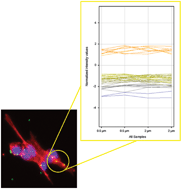Investigation of microsphere-mediated cellular delivery by chemical, microscopic and gene expression analysis†
Abstract

* Corresponding authors
a
Chemical Biology Section, School of Chemistry, University of Edinburgh, West Mains Road, Edinburgh, UK
E-mail:
mark.bradley@ed.ac.uk
Fax: +44 (0)131 650 6453
Tel: +44 (0)131 651 3307
b MRC Center for Regenerative Medicine, Institute for Stem Cell Research, University of Edinburgh, West Mains Road, Edinburgh, UK

 Please wait while we load your content...
Something went wrong. Try again?
Please wait while we load your content...
Something went wrong. Try again?
L. M. Alexander, S. Pernagallo, A. Livigni, R. M. Sánchez-Martín, J. M. Brickman and M. Bradley, Mol. BioSyst., 2010, 6, 399 DOI: 10.1039/B914428E
To request permission to reproduce material from this article, please go to the Copyright Clearance Center request page.
If you are an author contributing to an RSC publication, you do not need to request permission provided correct acknowledgement is given.
If you are the author of this article, you do not need to request permission to reproduce figures and diagrams provided correct acknowledgement is given. If you want to reproduce the whole article in a third-party publication (excluding your thesis/dissertation for which permission is not required) please go to the Copyright Clearance Center request page.
Read more about how to correctly acknowledge RSC content.
 Fetching data from CrossRef.
Fetching data from CrossRef.
This may take some time to load.
Loading related content
